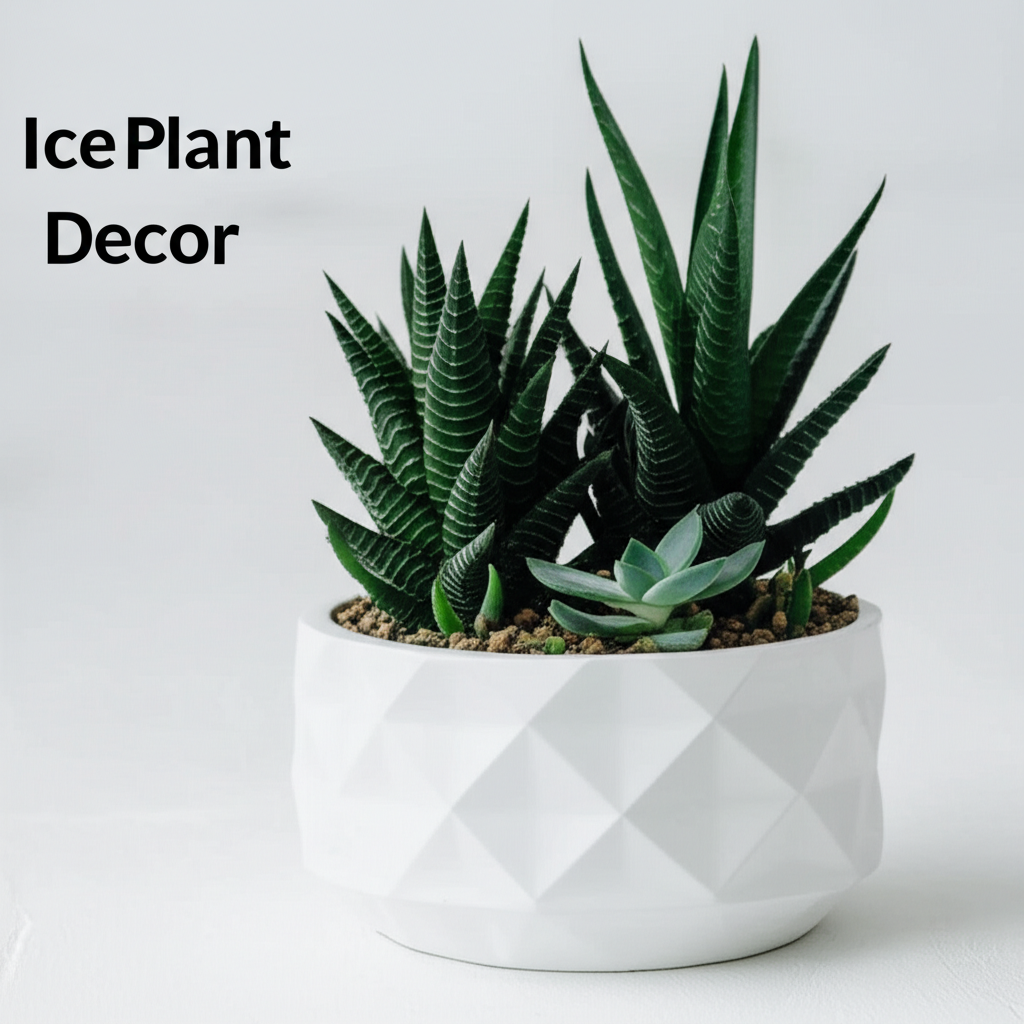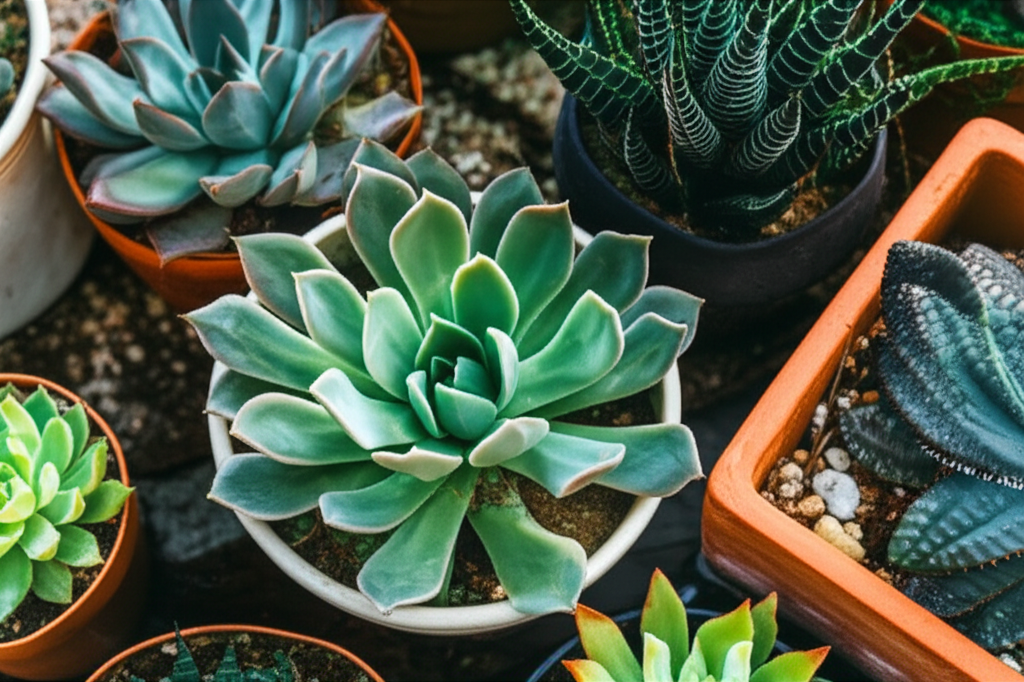Introduction to Ice Plant Succulents
What are Ice Plants?
Ice plants, scientifically known as members of the Aizoaceae family, are a diverse group of succulents celebrated for their unique appearance and low-maintenance nature. Their name comes from the glistening, crystalline structures that cover their leaves, which are actually specialized epidermal cells called papillae. These papillae are filled with water and refract light, giving the impression of ice crystals. This adaptation helps the plants conserve moisture in arid environments and can also protect them from intense sunlight.
Why Choose Ice Plants for Pot Arrangements?
Ice plants are an excellent choice for decorative pot arrangements due to several key characteristics:
- Unique Aesthetics: The “ice” effect is visually striking and adds a touch of the extraordinary to any setting.
- Low Maintenance: They are drought-tolerant and require minimal watering once established.
- Variety: The Aizoaceae family encompasses a wide range of forms, colors, and textures, allowing for creative and diverse arrangements.
- Compact Growth: Many varieties remain relatively small, making them ideal for container gardening and decorative displays.
- Adaptability: They thrive in bright light conditions, making them suitable for sunny windowsills, balconies, and patios.
Common Types of Ice Plants for Arrangements
While the Aizoaceae family is vast, a few specific genera are particularly popular for decorative arrangements:
- Mesembryanthemum: Often referred to as “common ice plants,” these are readily available and offer a vibrant display of daisy-like flowers.
- Delosperma: Known as “hardy ice plants,” these varieties are more cold-tolerant and produce prolific blooms.
- Lithops: Commonly called “living stones,” these are fascinating, slow-growing succulents that perfectly mimic pebbles, offering a minimalist yet captivating appeal.
- Fenestraria: Another “living stone” type, these succulents have translucent “windows” at the tips of their leaves, allowing light to penetrate for photosynthesis.
Designing Your Ice Plant Succulent Pot Arrangement

Choosing the Right Pot
The pot is as crucial as the plants themselves in creating a stunning arrangement. Consider these factors:
- Material: Terracotta pots are excellent for succulents as they are porous, allowing for good airflow and drainage, which helps prevent root rot. Glazed ceramic or concrete pots can also work but ensure they have adequate drainage holes.
- Drainage: This is non-negotiable. Your pot must have drainage holes to prevent waterlogging.
- Size: Choose a pot that is appropriately sized for the plants you intend to use. A pot that is too large can lead to overwatering issues, while one that is too small will restrict root growth. Aim for a pot that is about 1-2 inches wider than the combined root balls of your plants.
- Style: The pot’s style should complement the aesthetic of the ice plants. A rustic terracotta pot might suit a collection of ‘living stones,’ while a more modern ceramic pot could enhance vibrant, flowering ice plants.
Selecting Your Ice Plants
Variety is the spice of life, and this holds true for ice plant arrangements. Aim for a mix of textures, colors, and growth habits.
- Focal Point: Choose one or two striking plants that will draw the eye. This could be a particularly vibrant Mesembryanthemum or a uniquely shaped Lithops.
- Fillers: Select plants with trailing or mounding habits to fill in gaps and create a fuller look. Delosperma varieties often excel here.
- Texture Contrast: Mix plants with fleshy, rounded leaves with those that have more angular or segmented forms.
- Color Palette: While many ice plants are green, some varieties offer purples, reds, or blues, especially when exposed to strong sunlight. Consider a cohesive color scheme or a vibrant contrast.
Creating a Balanced Composition
The art of arrangement lies in balance and visual harmony.
- Height Variation: Place taller plants towards the back or center and shorter, trailing varieties towards the front or edges.
- Color Distribution: Spread out colors evenly to avoid clumping, or create a focal point with a concentrated burst of color.
- Texture Flow: Arrange plants so that their textures transition smoothly from one to another, guiding the viewer’s eye through the arrangement.
- Negative Space: Don’t overcrowd the pot. Leaving a little negative space can make the arrangement appear more sophisticated and allow individual plants to stand out.
Essential Care for Your Ice Plant Arrangements
Soil and Potting Mix
Succulents, including ice plants, require well-draining soil to thrive.
- Cactus/Succulent Mix: This is the easiest option, readily available at garden centers.
- DIY Mix: You can create your own by combining:
- 1 part potting soil
- 1 part coarse sand (horticultural grade)
- 1 part perlite or pumice
This gritty mix ensures excellent aeration and drainage, preventing root rot.
Watering Practices
Proper watering is paramount for ice plant success.
- “Soak and Dry” Method: Water thoroughly until water drains from the bottom of the pot. Then, allow the soil to dry out completely before watering again.
- Frequency: Watering frequency will depend on environmental factors like temperature, humidity, and light. In warmer months, you may need to water more often, while in cooler months, water sparingly.
- Signs of Thirst: Wrinkled or deflated leaves can indicate a need for water.
- Signs of Overwatering: Yellowing, mushy leaves, or rot at the base of the plant are clear indicators of too much moisture.
Light Requirements
Ice plants generally thrive in bright light.
- Full Sun to Partial Shade: Most ice plants prefer at least six hours of direct sunlight per day.
- Acclimation: If moving plants from a shaded area to full sun, do so gradually to prevent sunburn.
- Indoor Placement: A south-facing or west-facing window is ideal for indoor arrangements.
Temperature and Fertilization
- Temperature: Ice plants are generally tolerant of warm temperatures. Some varieties, like Delosperma, can also withstand cooler temperatures. Protect them from hard frosts.
- Fertilization: Ice plants are not heavy feeders. You can fertilize them once or twice during the growing season (spring and summer) with a diluted succulent or general-purpose fertilizer. Avoid fertilizing during their dormant period (usually winter).
Troubleshooting Common Issues
Root Rot
This is the most common problem for succulents and is almost always caused by overwatering and poor drainage.
- Prevention: Use well-draining soil and a pot with drainage holes. Allow the soil to dry out completely between waterings.
- Treatment: If you suspect root rot, carefully remove the plant from its pot. Trim away any mushy, brown, or black roots. Allow the remaining roots to air dry for a day or two before repotting in fresh, dry soil.
Pests
Ice plants are generally pest-resistant, but they can occasionally be affected by common succulent pests.
- Mealybugs: These white, cottony insects can be found in leaf axils and on stems. They can be treated with rubbing alcohol on a cotton swab or insecticidal soap.
- Aphids: Small, soft-bodied insects that can cluster on new growth. They can be washed off with a strong spray of water or treated with insecticidal soap.
Leaf Discoloration
- Yellowing Leaves: Often a sign of overwatering or insufficient light.
- Reddish/Purplish Tinge: This is usually a positive sign, indicating the plant is receiving ample sunlight and is healthy.
Key Facts and Comparison Table
This table provides a quick overview of common ice plant types and their suitability for arrangements:
| Ice Plant Type | Scientific Name (Genus) | Key Characteristics | Ideal For Arrangements | Bloom Color | Hardiness (USDA Zones) |
|---|---|---|---|---|---|
| Common Ice Plant | Mesembryanthemum | Fleshy leaves, daisy-like flowers, can spread. | Ground cover effect, cascading spillers. | Various (pink, purple, white, yellow) | 9-11 (some varieties may tolerate lighter frost) |
| Hardy Ice Plant | Delosperma | Low-growing, mat-forming, prolific bloomer. | Trailing plants, filling in gaps, rock gardens. | Various (pink, purple, yellow, orange, red) | 5-9 |
| Living Stones | Lithops | Extremely slow-growing, mimics pebbles, unique appearance. | Minimalist arrangements, focal points. | Yellow, white, orange | 10-11 |
| Window Plant | Fenestraria | Finger-like leaves with translucent tips (“windows”). | Edging plants, unique textures. | White or yellow | 9-11 |
Step-by-Step Guide to Creating Your Arrangement
Here’s a practical guide to assembling your ice plant succulent pot arrangement:
| Step | Action | Notes |
|---|---|---|
| 1 | Prepare the Pot: Ensure your chosen pot has drainage holes. If not, drill some yourself. Clean the pot thoroughly. | A clean pot helps prevent the spread of diseases. |
| 2 | Add Drainage Layer (Optional but Recommended): Place a layer of gravel or broken pottery shards at the bottom of the pot. | This further enhances drainage, especially in pots without ample drainage holes. |
| 3 | Add Potting Mix: Fill the pot about two-thirds full with your well-draining succulent mix. | Leave enough space at the top for the plants and for watering. |
| 4 | Arrange the Plants: Before planting, place your selected ice plants on top of the soil to visualize the arrangement. Experiment with different placements. | Consider height, color, and texture to achieve a balanced composition. |
| 5 | Plant the Succulents: Gently remove each ice plant from its nursery container. Loosen any tightly bound roots. Place them in the pot according to your planned arrangement. | Avoid planting too deeply; the crown of the plant should be at soil level. |
| 6 | Fill in with Soil: Add more potting mix around the plants, firming gently to remove air pockets. Leave about an inch of space between the soil surface and the rim of the pot. | This space allows for watering without spillage. |
| 7 | Top Dressing (Optional): Add a layer of decorative gravel, pebbles, or sand to the surface of the soil. | This not only looks attractive but also helps retain moisture and suppress weeds. |
| 8 | Initial Watering (Lightly): Water the arrangement very lightly after planting. | Allow the plants to settle in before a thorough watering cycle begins. Wait a day or two for this. |
| 9 | Placement: Place the newly arranged pot in a location that receives the appropriate amount of sunlight. | Observe the plants for the first few days to ensure they are adapting well. |
Pros and Cons of Ice Plant Succulent Arrangements
This table outlines the advantages and disadvantages to consider:
| Pros | Cons |
|---|---|
| Unique Visual Appeal: The crystalline structures of ice plants create a distinctive and eye-catching display. | Overwatering Sensitivity: Ice plants are susceptible to root rot if overwatered, requiring careful attention to watering schedules. |
| Low Maintenance: Once established, they are drought-tolerant and require minimal care. | Light Requirements: Most varieties need plenty of direct sunlight, which might limit indoor placement options for some individuals. |
| Drought Tolerance: Excellent for arid climates or for those who tend to forget to water. | Pest Susceptibility: While generally hardy, they can occasionally be targeted by common succulent pests like mealybugs. |
| Variety of Forms and Colors: A wide range of species offers diverse textures, shapes, and flowering colors to choose from. | Slow Growth (for some): Species like Lithops grow very slowly, so immediate dramatic changes in the arrangement are unlikely. |
| Attracts Pollinators: Many ice plants produce bright, attractive flowers that can draw bees and other beneficial insects. | Frost Sensitivity: Many common varieties are not frost-tolerant and require protection in colder climates. |
Conclusion: Bringing the Sparkle of Ice Plants to Your Space
Creating an ice plant succulent decorative pot arrangement is a rewarding endeavor that combines the art of design with the pleasure of low-maintenance gardening. By understanding the unique needs of these captivating plants and paying attention to pot selection, soil composition, and watering practices, you can cultivate a living display that brings a touch of shimmering beauty and resilient charm to any home or garden. Experiment with different combinations, observe how your plants respond to their environment, and enjoy the ever-evolving spectacle that your ice plant arrangement provides.


